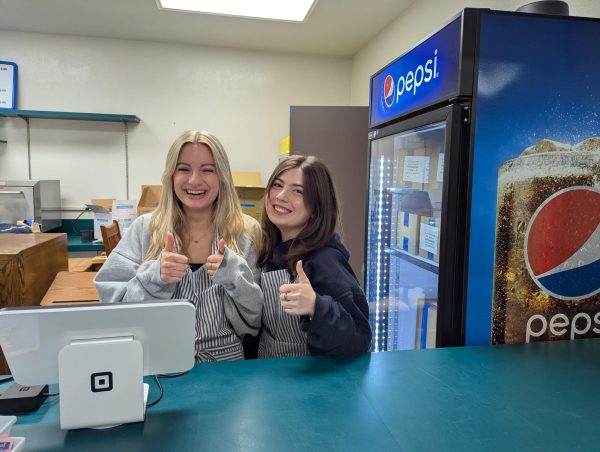Online learning at Jesuit
One of the many iPads that Jesuit students use to communicate with during Digital Learning Days.
Schools have been utilizing new technology to provide education for students amidst school shutdowns. By providing students with an accessible way to still communicate with teachers and complete work at their own pace, schools have taken full advantage of digital learning to continue the teaching that would otherwise occur within the physical classroom daily. This additionally eliminates the need to extend the school year for the time period of a school being shut down.
Online learning has become necessary with the rampant COVID-19 pandemic now closing schools on a global scale.
Specifically, Jesuit has transitioned to this method of learning because of the convenient usage of Canvas LMS and iPads administered to all students. Ever since digital learning at Jesuit began during the snowstorm of the 2016-17 year, the school has continued to use it sparingly. Now, with the threat of school being missed for several weeks, digital learning has been employed in a timely and recognizable manner.
One significant benefit of using these digital learning days is that they prevent school from being pushed further into the summer. Online learning also works great because of the way that students can complete their work and easily submit assignments via their iPad efficiently for teachers to grade digitally. Many students also appreciate the idea that they can work at their own pace throughout the day and enjoy the liberties of working at home instead of sitting inside classrooms.
“I originally thought the digital learning days would grief my senior year, but with the help of teachers and friends, I found it to be helpful in some ways,” said senior Nick Noonan. “It’s teaching me to be independent.”
There are some downsides to online learning, however. First, interactions over email with teachers and other classmates don’t provide the same learning experience that a student would get out of interacting with teachers and classmates face-to-face. Another factor that sometimes doesn’t work has to do with the amount of time students are willing to put into their work online. With the freedom to do other activities outside of school, students can sometimes neglect their work. On the contrary, other students can put too much time into online work that may amass with all of their courses.
In fact, when Jesuit first employed digital learning days in 2017, the school sent out a survey to better understand the variability in how much time students were putting into their work.
When it comes to the strategies of teachers, many are using a widespread availability of resources online to communicate information and material to students. This may be as simple as uploading a PDF or PowerPoint for students or using Canvas discussions to answer questions. Other teachers plan for students to use apps outside of Canvas, such as the installed Google Meet app so students can collaborate for group projects.
With these various new strategies for interacting, students are discovering the tools and tactics teachers utilize that they prefer. Digital Learning Days (DLDs) were just recently established 4 years ago, so continuing educational routines through solely technology has still introduced some difficulties for both students and teachers.
While students have their own apps and communication tools that they favor, junior Afua Pinamang-Boampong has noticed the increased stress on deadlines that DLDs bring.
“I have liked it when teachers spread out the due dates, so they’re not too close together, and I can do other classwork,” Pinamang-Boampong said. “But I don’t like when [assignments are] due the next morning. It’s just too much.”
In addition, learning large concepts has been a struggle when learning through only an iPad. Individual assistance from a teacher is difficult to obtain through technology, and some classes only include repetitive “busy” work.
“It’s really stressful,” Pinamang-Boampong said. “I feel like I don’t have enough time to do anything, and it’s weird doing work at home. I feel like I’m not learning [much] too…It’s also really stressful when each day [I’m] doing the same thing.”
With Online Learning altering the schedules of both students and teachers drastically, DLDs do not feel like “real school.” Without the face-to-face interactions between students and faculty, as well as discipline from teachers, completing work is difficult. Group projects, larger tests, and papers with collaboration are also difficult to complete, and students are provided with much more freedom to manage time the way they choose. DLDs may be difficult on both students and faculty, but the lack of structure has provided opportunities for students to work independently.

Scout Jacobs is a managing editor for the Jesuit Chronicles at Jesuit High School. As a senior in high school, this is her third year doing Journalism, and she loves to write. Journalism has been a primary passion of hers throughout highschool, and she hopes to continue this passion through college. Outside of school and writing, Scout enjoys reading, hanging out with friends, and listening to music. She is on the swim team at Jesuit, and has been swimming since she was a freshman. Born and raised in Portland, OR, Scout has an older brother who graduated Jesuit last year, who is now attending Seattle University. In her free time, she is usually watching a movie or spending time with her family at home or at fun destinations around Portland. Her favorite subject in school is English, and she has been taking French throughout her high school career in hopes of becoming fluent in the language. She loves the outdoors, and her favorite activity to do with friends is to go on a hike or go swimming. During the weekends and long breaks, Scout usually visits her family in Seattle, where most of her extended family lives. Both of her parents are architects, and she loves hearing about their work and the creativity they use to feel passionate about their work.

Michael Lang is going into his senior year at Jesuit High School. Born in Portland, Oregon, Michael has two older siblings at the University of Portland and a younger brother who also attends Jesuit as a Junior. In his free time, Michael loves to play CYO basketball with his friends in the winter and to also hang out with his friends whenever possible on the weekends. Aside from friends, he enjoys spending time with his family during family reunions or on vacations in the summer, this year including trips to Las Vegas and the beach at Manzanita. He also has fun golfing with his dad and brother, too. In addition, Michael will be a Jesuit Ambassador for the second year and loves to welcome prospective students to the school through shadow visits and Open Houses. He looks forward to college in the coming years. Currently, this is Michael’s first year as a journalist for Jesuit High School and he looks forward to getting to know many more members of the community through future writing and interviews with students and staff. He hopes to be able to effectively display the academic, athletic, and social excitements and struggles of the students of Jesuit through writing in the school newspaper.








